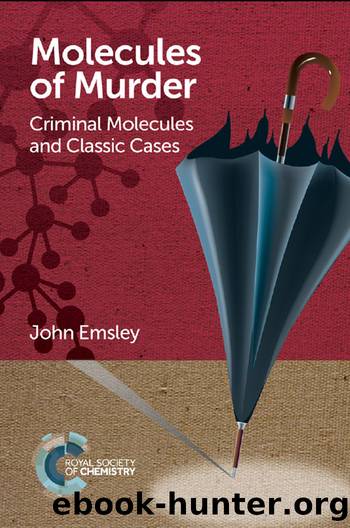Molecules of Murder: Criminal Molecules and Classic Cases by John Emsley

Author:John Emsley [Emsley, John]
Language: eng
Format: epub
Tags: Science, History
ISBN: 9780854049653
Goodreads: 4314000
Publisher: Royal Society of Chemistry
Published: 2008-08-01T00:00:00+00:00
6.3 But is Chloroform Safe?
Far more worrying to doctors as a whole were reports that some patients had died suddenly under the influence of chloroform. An early example of an inexplicable death occurred on Friday, 28 January 1848, when Hannah Greener of Newcastle-upon-Tyne was being operated on for an ingrowing nail on the big toe of her right foot. The corresponding nail on her left foot had been removed a few months earlier, with ether as anaesthetic. The family doctor now decided to use chloroform, but within a few minutes her breathing became rapid, then suddenly stopped. She was deadâthe chloroform had killed her. Or had it? So began a controversy about the safety of this anaesthetic that was to rage for more than 50 years.
As we shall see, such sudden deaths occasionally occurred in England, but were rare in Scotland, India or France. And before it could be proved that chloroform was indeed a risk to life the head of the worldâs greatest empire, Queen Victoria, decided to try itâunder the care of the worldâs most experienced anaesthetist, Dr John Snow (1813â1858). When she consulted him he was 40 years old and an advocate of healthy livingâhe was a vegetarian and a total abstainer from alcohol.ii Snow is best remembered for removing the handle of the Broad Street pump in 1853, thereby bringing to an end the cholera epidemic which had been the scourge of the Soho area of central London. His epidemiological observations linked the incidence of the disease to water from the pump, which was contaminated by faeces. This was before doctors fully realised the nature of disease pathogens, the importance of which only became clear following the work of Louis Pasteur (1822â1895) some 25 years later.
Snow had previously used ether when called upon to anaesthetise patients for operations, tooth extractions or childbirth, but he was converted to the use of chloroform. He advised only light anaesthesia for women in labour, because he observed that babies born under its influence were less vigorous during the crucial early minutes of life. Snow recognised five states of chloroform anaesthesia: in the first and lightest, the patient remained conscious but elated as if drunk; during the second state the patient was still conscious but in a dream-like trance, which was the one he preferred in the case of a woman in labour; in the third state the patient was unconscious, relaxed, and no longer responsive to pain, the preferred state for surgery; in the fourth stage the patient was unconscious and breathing deeply, which he advocated only for the most difficult operations. In the fifth state, which he studied on animals, breathing became strained as the chest muscles became partially paralysed. Snow was aware that there was a fine line between states three, four and five. The third state was produced with about 1 ml of chloroform (25 drops), whereas double this amount could result in the fourth or even the fifth state. How much chloroform a patient actually inhaled
Download
This site does not store any files on its server. We only index and link to content provided by other sites. Please contact the content providers to delete copyright contents if any and email us, we'll remove relevant links or contents immediately.
Harry Potter and the Goblet Of Fire by J.K. Rowling(3046)
Unfinished: A Memoir by Priyanka Chopra Jonas(2918)
Never by Ken Follett(2884)
The Man Who Died Twice by Richard Osman(2300)
Machine Learning at Scale with H2O by Gregory Keys | David Whiting(2293)
Fairy Tale by Stephen King(2072)
Will by Will Smith(2043)
Rationality by Steven Pinker(1765)
The Storyteller by Dave Grohl(1662)
The Dawn of Everything: A New History of Humanity by David Graeber & David Wengrow(1571)
The Dark Hours by Michael Connelly(1571)
The Stranger in the Lifeboat by Mitch Albom(1532)
Cloud Cuckoo Land by Anthony Doerr(1435)
The Becoming by Nora Roberts(1331)
Friends, Lovers, and the Big Terrible Thing by Matthew Perry(1330)
New Morning Mercies: A Daily Gospel Devotional by Paul David Tripp(1325)
Crying in H Mart by Michelle Zauner(1316)
Einstein: His Life and Universe by Walter Isaacson(1315)
A Short History of War by Jeremy Black(1300)
